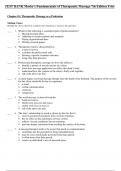Exam (elaborations)
Test Bank For Mosby's Fundamentals of Therapeutic Massage 7th Edition by Sandy Fritz, Luke Fritz
- Course
- Institution
Test Bank Mosby's Fundamentals of Therapeutic Massage 7th Edition by Sandy Fritz, Luke Fritz ISBN: 9780323661836. Mosby's Fundamentals of Therapeutic Massage 7e test bank.
[Show more]



